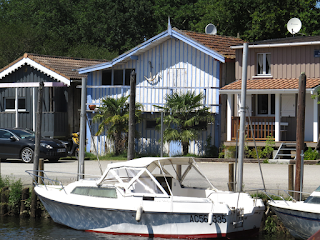We were finishing up back by the sea again...Arcachon Bay is a very tidal area in the Aquitaine region of France; at high tide the bay covers an area of 150 km², and only 40 km² when the tide is out. The beaches on the coast north and south of the mouth of the bay are beautiful, golden and sandy with the Atlantic sea providing great waves - and strong currents in places. We did go to one of the beaches inside the bay area on our last day - but in the end I didn't swim. It was quite a small area, almost like a salt pool and almost seemed to smell stale, and I had been spoiled by the beautiful beaches we had been on previously. Perhaps for novelty value I should have! It would probably have been warmer than the Atlantic.
 |
| Mimosa trees were in full bloom everywhere |
The following photos are from Biganos Port. In the evening of the day we arrived, we set off with the town map given to us at the campsite reception, hoping to find one of the two ports. In the end I think we gave up about 50 metres short of actually finding it - but on the other hand, we weren't looking for something built around two or three river channels extending into the delta! I should have done more homework before we arrived. It was extremely picturesque and scenic. The owners of the little cabins put a lot of love and care into decorating them. We had to cut the walk short, though, when one of my flip-flops broke. Biganos is the larger of the two ports.
















































